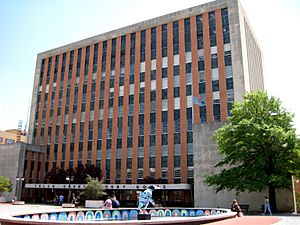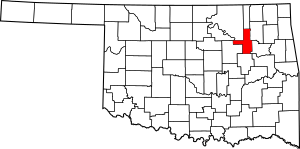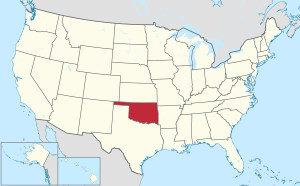Tulsa County, Oklahoma facts for kids
Quick facts for kids
Tulsa County
|
||
|---|---|---|

Tulsa County Courthouse
|
||
|
||

Location within the U.S. state of Oklahoma
|
||
 Oklahoma's location within the U.S. |
||
| Country | ||
| State | ||
| Founded | 1907 | |
| Named for | city of Tulsa | |
| Seat | Tulsa | |
| Largest city | Tulsa | |
| Area | ||
| • Total | 587 sq mi (1,520 km2) | |
| • Land | 570 sq mi (1,500 km2) | |
| • Water | 17 sq mi (40 km2) 2.9%% | |
| Population
(2020)
|
||
| • Total | 669,279 | |
| • Estimate
(2023)
|
682,868 |
|
| • Density | 1,140.2/sq mi (440.2/km2) | |
| Time zone | UTC−6 (Central) | |
| • Summer (DST) | UTC−5 (CDT) | |
| Congressional district | 1st | |
Tulsa County is a county in Oklahoma, a state in the United States. In 2020, about 669,279 people lived there. This makes it the second-largest county in Oklahoma by population.
The main city and county seat is Tulsa, which is also the second-biggest city in the state. Tulsa County was created in 1907 when Oklahoma became a state. It was named after the city of Tulsa. Before Oklahoma became a state, this area was part of the Creek Nation and Cherokee Nation. Tulsa County is part of the larger Tulsa metropolitan area. It is known for being the most crowded county in Oklahoma and also has a high average income.
Contents
History of Tulsa County
The story of Tulsa County is closely linked to the history of the city of Tulsa. This section shares important events that happened mostly outside the city of Tulsa.
Early Discoveries at Lasley Vore Site
The Lasley Vore Site is a special place along the Arkansas River south of Tulsa. In 1988, scientists found old tools and items there. These finds suggest that a French explorer named Jean-Baptiste Bénard de la Harpe might have met the Wichita people here in 1719.
Old Fort Arbuckle
Long ago, the U.S. Government moved Native American tribes from the southeastern U.S. to "Indian Territory". This land was already used by other tribes like the Osage. To protect the new settlers, the government built military posts.
In 1833, soldiers built a fort called "Fort Arbuckle." It was named after General Matthew Arbuckle. The fort was located about 8 miles (13 km) west of where Sand Springs, Oklahoma is today. However, the fort was closed just a year later, in 1834. The area where the fort once stood is now covered by Keystone Lake.
Battle of Chusto-Talasah
During the American Civil War (1861-1865), some Creek and Seminole people in Indian Territory supported the U.S. Government. In November 1861, Confederate soldiers attacked these Union supporters.
A battle happened on December 9, 1861, at Chusto-Talasah. This place was on Bird Creek, in what is now Tulsa County. The Confederate soldiers won this battle, pushing the Union supporters away.
Arrival of Railroads
In 1883, the Atlantic and Pacific Railroad built its tracks to Tulsa. It stopped on the east side of the Arkansas River. Later, the company built a strong steel bridge across the river. This bridge helped ranchers move their cattle easily. It also made it simpler for workers to get to the oil fields after oil was found in Red Fork in 1901.
The Oil Boom
On June 25, 1901, a well called Sue Bland No. 1 struck oil! It was a huge gusher near the town of Red Fork. The land belonged to Sue A. Bland, a Creek citizen. This discovery led to a big "oil boom" in the area.
Soon, more oil wells were found. The next major oil discovery in Tulsa County was the Glenn Pool Oil Reserve. This led to the founding of Glenpool, Oklahoma. Even though Tulsa became known as the "Oil Capital of the World," drilling for oil was not allowed inside the city limits.
Tulsa County Courthouse
Between 1911 and 1912, Tulsa County built a courthouse in Tulsa. It was a large building made of special marble. This building became famous for a sad reason. On May 31, 1921, a crowd gathered there, which led to the start of the Tulsa Race Massacre.
The old courthouse was later torn down. A new courthouse was built at a different location. The land where the old courthouse stood is now home to the Bank of America building.
1921 Tulsa Race Massacre
In the early 1900s, Tulsa had a very successful Black community called "Black Wall Street" in the Greenwood neighborhood. It was one of the richest Black communities in the U.S.
However, on May 31 and June 1, 1921, a terrible event happened. Mobs of white residents attacked the Black community. They killed people, stole from homes and businesses, and burned down many buildings. This event is known as the Tulsa Race Massacre. It lasted for 16 hours until the Governor sent in the National Guard.
Reports say that many people died, mostly Black citizens. Over 800 people were hurt, and about 1,000 Black people lost their homes. About 35 city blocks and 1,256 homes were destroyed by fire. In recent years, the city and state have worked to remember and acknowledge this sad part of history.
Geography and Climate
Tulsa County covers about 587 square miles (1,520 km²). About 570 square miles (1,476 km²) is land, and 17 square miles (44 km²) is water.
The Arkansas River flows through most of the county. Part of Keystone Lake, which is formed by a dam on the Arkansas River, is also in the county. Other rivers like Bird Creek and the Caney River drain the northern parts of Tulsa County.
| Monthly Normal and Record High and Low Temperatures | ||||||||||||
| Month | Jan | Feb | Mar | Apr | May | Jun | Jul | Aug | Sep | Oct | Nov | Dec |
|---|---|---|---|---|---|---|---|---|---|---|---|---|
| Rec High °F | 79 | 90 | 96 | 102 | 96 | 103 | 112 | 110 | 109 | 98 | 87 | 80 |
| Norm High °F | 46.5 | 52.9 | 62.4 | 72.1 | 79.6 | 88 | 93.8 | 93.2 | 84.1 | 74 | 60 | 49.6 |
| Norm Low °F | 26.3 | 31.1 | 40.3 | 49.5 | 59 | 67.9 | 73.1 | 71.2 | 62.9 | 51.1 | 39.3 | 29.8 |
| Rec Low °F | -8 | -11 | -3 | 22 | 35 | 49 | 51 | 52 | 35 | 18 | 10 | -8 |
| Precip (in) | 1.6 | 1.95 | 3.57 | 3.95 | 6.11 | 4.72 | 2.96 | 2.85 | 4.76 | 4.05 | 3.47 | 2.43 |
| Source: USTravelWeather.com [1] | ||||||||||||
Neighboring Counties
- Washington County (north)
- Rogers County (northeast)
- Wagoner County (southeast)
- Okmulgee County (south)
- Creek County (west)
- Pawnee County (northwest)
- Osage County (northwest)
Main Roads
 Interstate 44
Interstate 44 Interstate 244
Interstate 244 Interstate 444
Interstate 444 U.S. Route 64
U.S. Route 64 U.S. Historic Route 66
U.S. Historic Route 66 U.S. Route 75
U.S. Route 75 U.S. Route 169
U.S. Route 169 U.S. Route 412
U.S. Route 412 Creek Turnpike
Creek Turnpike Oklahoma State Highway 11
Oklahoma State Highway 11 Former Oklahoma State Highway 12
Former Oklahoma State Highway 12 Oklahoma State Highway 20
Oklahoma State Highway 20 Oklahoma State Highway 51
Oklahoma State Highway 51 Oklahoma State Highway 67
Oklahoma State Highway 67 Oklahoma State Highway 97
Oklahoma State Highway 97 Oklahoma State Highway 97T
Oklahoma State Highway 97T Oklahoma State Highway 117
Oklahoma State Highway 117 Oklahoma State Highway 151
Oklahoma State Highway 151 Oklahoma State Highway 266
Oklahoma State Highway 266 Oklahoma State Highway 364
Oklahoma State Highway 364- Gilcrease Expressway
- L.L. Tisdale Parkway
Public Transportation
- Tulsa Transit (local buses)
- Greyhound Lines (long-distance buses)
- Jefferson Lines (long-distance buses)
Population Facts
| Historical population | |||
|---|---|---|---|
| Census | Pop. | %± | |
| 1910 | 34,995 | — | |
| 1920 | 109,023 | 211.5% | |
| 1930 | 187,574 | 72.0% | |
| 1940 | 193,363 | 3.1% | |
| 1950 | 251,686 | 30.2% | |
| 1960 | 346,038 | 37.5% | |
| 1970 | 401,663 | 16.1% | |
| 1980 | 470,593 | 17.2% | |
| 1990 | 503,341 | 7.0% | |
| 2000 | 563,299 | 11.9% | |
| 2010 | 603,403 | 7.1% | |
| 2020 | 669,279 | 10.9% | |
| 2023 (est.) | 682,868 | 13.2% | |
| U.S. Decennial Census 1790-1960 1900-1990 1990-2000 2010-2019 |
|||
In 2010, about 603,403 people lived in Tulsa County. The population included many different groups. About 69.2% were White, 10.7% Black or African American, and 6.0% Native American. About 11.0% of the population was Hispanic or Latino.
By 2020, the population grew to 669,279 people. In 2021, the county had about 295,350 households. The average home value was $168,800, and the average rent was $929.
In 2010, about 26.3% of the people were under 18 years old. The average age was 34 years. The median income for a household was $47,005. About 15.1% of the population lived below the poverty line. Many adults in the county have a high school diploma, and almost 30% have a college degree or higher.
Parks and Fun Activities
River Parks is a great place for outdoor fun in Tulsa County. It was started in 1974 by the city and county. These parks stretch along the Arkansas River for about 10 miles (16 km). They have new trails, beautiful landscaping, and playgrounds.
The River Parks Turkey Mountain Urban Wilderness Area is on the west side of the Arkansas River. It's a large area of 300 acres (121 ha) with over 45 miles (72 km) of dirt trails. You can go hiking, trail running, mountain biking, or horseback riding there. You can even borrow bicycles from the "Tulsa Townies" group at different spots in the parks.
Communities
Cities
- Bixby (part)
- Broken Arrow (part)
- Collinsville
- Glenpool
- Jenks
- Owasso (part)
- Sand Springs (part)
- Sapulpa (part)
- Skiatook (part)
- Tulsa (county seat) (part)
Towns
Census-Designated Places
Unincorporated Communities
Past Communities
- Alsuma - Became part of Tulsa in 1968.
- Carbondale - Became part of Tulsa in 1928.
- Dawson - Became part of Tulsa in 1949.
- Keystone - Covered by Keystone Lake when it was built in 1958.
- North Tulsa - Became part of Tulsa in 1904.
- Prattville - Became part of Sand Springs in 1965.
- Red Fork - Became part of Tulsa in 1927.
- South Haven - Became part of Tulsa in 1966.
Education
Schools (K-12)
Public school districts in Tulsa County include:
- Berryhill Public Schools
- Bixby Public Schools
- Broken Arrow Public Schools
- Collinsville Public Schools
- Glenpool Public Schools
- Jenks Public Schools
- Liberty Public Schools
- Owasso Public Schools
- Sand Springs Public Schools
- Skiatook Public Schools
- Sperry Public Schools
- Tulsa Public Schools
- Union Public Schools
- Keystone Public School (elementary only)
Colleges and Universities
Public colleges:
- University of Tulsa
- Tulsa Community College
Private colleges:
- Oral Roberts University
Historic Places (NRHP Sites)
Many places in Tulsa County are listed on the National Register of Historic Places. This means they are important historical sites.
- 66 Motel, Tulsa
- Ambassador Hotel, Tulsa
- Bishop Kelley High School
- Boston Avenue United Methodist Church, Tulsa
- Boulder-on-the-Park, Tulsa
- Brady Heights Historic District, Tulsa
- Broken Arrow Elementary--Junior High School, Broken Arrow
- Cain's Dancing Academy, Tulsa
- The Church Studio, Tulsa
- Circle Theater, Tulsa
- Clinton-Hardy House, Tulsa
- Tulsa Convention Hall, Tulsa
- Cosden Building, Tulsa
- Creek Council Oak Tree, Tulsa
- Dawson School, Tulsa
- Carl K. Dresser House, Tulsa
- Eleventh Street Arkansas River Bridge, Tulsa
- Fort Arbuckle Site, Sand Springs
- Gillette Historic District, Tulsa
- Gillette-Tyrell Building, Tulsa
- Harwelden Mansion, Tulsa
- Haskell State School of Agriculture, Broken Arrow
- Holy Family Cathedral, Rectory, and School, Tulsa
- Hooper Brothers Coffee Company Building, Tulsa
- Robert Lawton Jones House, Tulsa
- Maple Ridge Historic Residential District, Tulsa
- Mayo Building, Tulsa
- Mayo Hotel, Tulsa
- Mayo Motor Inn
- James H. McBirney House, Tulsa
- McFarlin Building, Tulsa
- Robert M. McFarlin House, Tulsa
- B. W. McLean House and Office, Jenks
- Mincks-Adams Hotel, Tulsa
- Moore Manor, Tulsa
- Mount Zion Baptist Church, Tulsa
- North Cheyenne Historic District, Tulsa
- Oil Capital of the World Historic District
- Oklahoma Natural Gas Company Building, Tulsa
- Owen Park Historic District, Tulsa
- Page Memorial Library, Sand Springs
- Foster B. Parriott House, Tulsa
- Petroleum Building, Tulsa
- Philcade Building, Tulsa
- Phillips 66 Station 473, Tulsa
- Waite Phillips Mansion (now Philbrook Museum), Tulsa
- Philtower, Tulsa
- Pierce Block, Tulsa
- Public Service of Oklahoma Building, Tulsa
- Ranch Acres Historic Residential District, Tulsa
- Riverside Historic Residential District, Tulsa
- Riverside Studio, Tulsa
- Sand Springs Power Plant, Sand Springs
- Sinclair Service Station, Tulsa
- William G. Skelly House, Tulsa
- Southwestern Bell Main Dial Building, Tulsa
- St. John Vianney Training School for Girls, Tulsa
- Swan Lake Historic District, Tulsa
- Tracy Park Historic District
- Tribune Building, Tulsa
- Tulsa Fire Alarm Building, Tulsa
- Tulsa Municipal Building, Tulsa
- United States Post Office and Courthouse, Tulsa
- James Alexander Veasey House, Tulsa
- Vickery Phillips 66 Station, Tulsa
- Westhope, Tulsa
- White City Historic District, Tulsa
- Woodward Park and Gardens Historic District
- Yorktown Historic District, Tulsa
See also
 In Spanish: Condado de Tulsa para niños
In Spanish: Condado de Tulsa para niños


